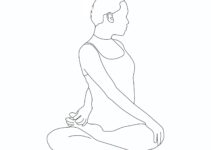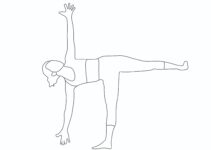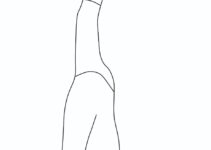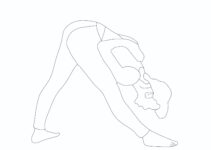What is the meaning of Ujjayi Pranayama?
This Pranayama is performed with both nostrils, while rechaka (exhalation) is done only through the left nostril. Partial closure of the glottis during practice produces the sound of ‘AUM’’ or humming. As you breathe, you hear a continuous sound emitted from the throat. It is not loud, audible to you but inaudible to another person unless he sits close to you. This sound is the most important characteristic of Ujjayi Pranayama, and the name is derived from this fact. This form of breathing, together with khechari mudra, is called ujjayi pranayama.

Explanation in Yogic texts
Haṭhapradīpika (2/ 51-52) explains that by closing the mouth, one should slowly draw in air through both the nostrils, producing a sound so that breath is felt from the throat to the chest. After performing kumbhaka as before, the air is exhaled through the left nostril. This removes throat diseases caused by phlegm and increases gastric fire.
How to perform Ujjayi Pranayama step by step
- Sit in Padmasana.
- Close the mouth. Contract the region at the back of the throat, inhale slowly through both nostrils smoothly and uniformly till the breath fills the space from the throat to the heart.
- During inhalation, a peculiar sound is produced owing to the partial closing of the glottis. This sound should be of mild and uniform pitch. It should be continuous also.
- Expand the chest while inhaling.
- Retain the breath for as long as one can do it comfortably.
- Then exhale slowly through the left nostril by closing the right nostril with the right thumb.
- Instead of exhaling through the left nostril, one can slowly exhale through both nostrils.
Health Benefits of Ujjayi Pranayama
- Ujjayi Pranayama removes heat from the head and keeps it cool.
- It increases digestive fire (Hatha Pradipika (H.P.) 2/52).
- It removes disorders of the nadis and the dhatu and prevents Vadodara (dropsy of the belly) (H.P. 2/53).
- It removes phlegm in the throat and prevents all pulmonary diseases (H.P. 2/53).
- It prevents diseases caused by short oxygen inhalation and cardiac diseases.
- Regular practice of this praṇayama defends the practitioner from diseases of phlegm, degeneration, dyspepsia, dysentery, enlarged spleen, cough or fever (Gherand Samhita 5/73).
- Combined with Aum, it is a perfect relaxation and premeditative technique.
- It calms the nervous system and removes all worries and troubles from the mind.
- People with insomnia should have a quiet, deep sleep if they practise this technique at night.
- It is good for the singers as it helps to make the voice clear. It is known for its clarity of sound, too.
Ujjayi Pranayama contraindications
This pranayama shouldn’t be performed in the following conditions.
- Low blood pressure
- Hypertension
- Cardiac disorders
- Asthma
- Dizziness
Ujjayi Pranayama precautions
- For those with cardiac issues and high blood pressure, the pranayama should be performed without Kumbhaka (retention of breath).
- While performing the pose, your spine, neck, and head should all form a straight line.
- Be aware of the breath flowing in and out of the nostrils.
- Try to feel breathing through the throat only.
- Many people contort their facial muscles when they do ujjayi. It should be skipped.
- Try to relax the face as much as possible.
- Do not over-contract the throat.
- The throat contraction should be slight and applied continuously throughout the practice.
Top facts about Ujjayi Pranayama
- The word Ujjayi is pronounced as ‘oo-jai’, comprised of two Sanskrit words: “ud” and the root “ji”. Ujji means ‘to be victorious’, and ‘Ud’ means ‘bondage’ and ‘upward’.
- It is known as ‘the ocean breath’, as the flow of air in the glottis (throat) resembles the sounds of waves, like in the ocean.
- This is one of the best yoga exercises to treat the thyroid.
- It is easy to learn and can be practised by all, young and old, at any time of the day or night.
- This practice teaches you to snore without sleeping.
- Here, breathing should sound like the gentle snoring of a sleeping baby.
- This practice, though simple, subtly influences the whole body and the psychic plane.
- This is a unique form of pranayama in which one makes a hissing or whispering sound in the throat region.
Different names
- Ocean breath
- Hissing Breath
- Victorious Breath
- Darth Vader Breath
Scientific evidence
- In a research study conducted at the National Institute of Mental Health and Neurosciences (NIMHANS), Bengaluru, it has been found that practising Ocean Breath increases oxygen consumption by 50% during practice.
- It helps reduce the body’s flight-or-flight response, thereby ensuring relaxation in the body (a).
Modifications and variations of Ocean breath
In comparison to other pranayama, it needs some practice to perform. Emitting sound from the throat by experiencing friction requires focus and attention. Advanced practitioners are also doing muscular lock (throat lock). It is just like Kumbhaka.
Ujjayi pranayama for Sportsperson
Ujjayi is quite beneficial for athletes as it helps improve their respiratory efficiency and also plays a vital role in relieving anxiety and stress.





